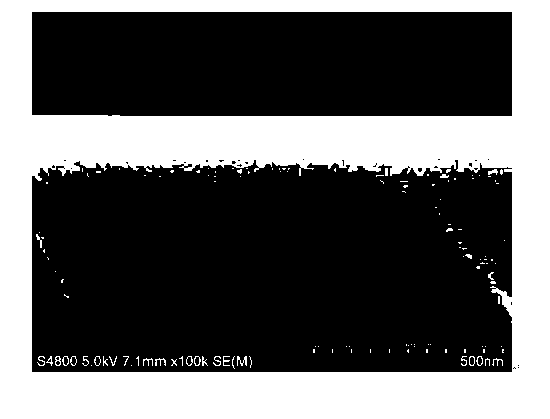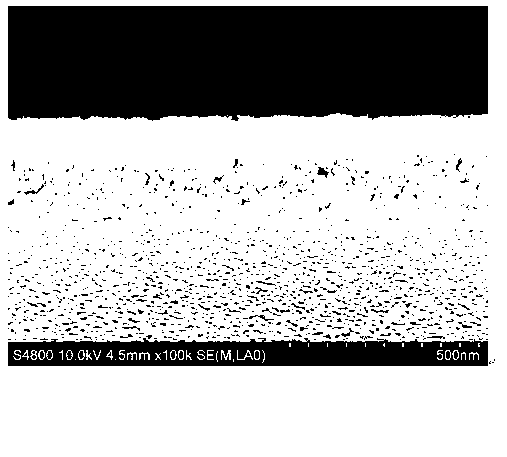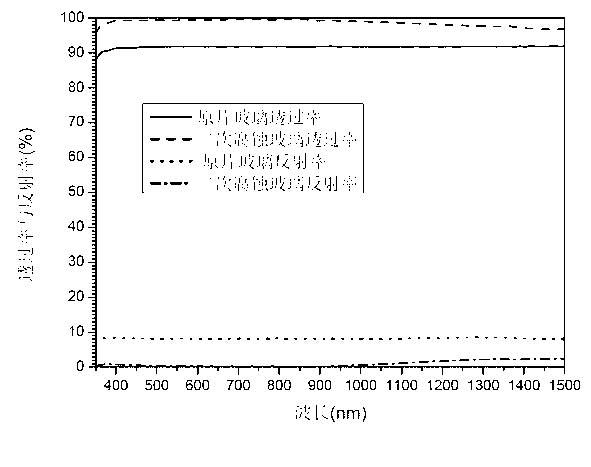Anti-reflecting glass and method for preparing same through secondary acid corrosion
An anti-reflection glass, acid corrosion technology, applied in the field of glass surface treatment, to achieve the effect of low cost
- Summary
- Abstract
- Description
- Claims
- Application Information
AI Technical Summary
Problems solved by technology
Method used
Image
Examples
Embodiment 1
[0019] Such as figure 2 Shown is an anti-reflection glass, which includes a glass substrate and an anti-reflection film on its surface, and the anti-reflection film is an anti-reflection film layer with a continuous gradient refractive index distribution. The thickness of the anti-reflection coating is 80-500 nanometers. The glass substrate is Na 2 O-CaO-SiO 2 System glass. figure 1 Shown is the SEM image of the cross-section of the glass substrate without anti-reflection treatment.
[0020] The measured transmittance and reflectance of anti-reflection glass, see image 3 . The "original glass" in the picture refers to the Na 2 O-CaO-SiO 2 System glass (soda-lime-silicon system glass) substrate, its transmittance before anti-reflection treatment is about 91%, and its reflectance is about 8%. The transmittance of visible light through the glass after treatment by the anti-reflection method can reach more than 99%, and the reflectivity is lower than 0.5%.
Embodiment 2
[0022] The photovoltaic, photothermal or building Na 2 O-CaO-SiO 2 The surface of the glass substrate of the system is cleaned with a cleaning agent, and then rinsed with deionized water. Put the glass substrate into the first containing concentration of 5%H 2 SO 4 The solution corroded the tank, and placed in the tank for 6 hours, and rinsed with deionized water after taking it out. Put the cleaned glass substrate into the second one containing 0.003% HF and 0.0006% Na 2 SiO 3 Place it in the corrosion tank for 15 hours, then take it out and clean it with deionized water. Put the cleaned glass substrate into a drying oven at 200°C, dry it for 90 minutes, turn off the heating switch of the oven, take it out of the oven when the temperature drops to 50°C, and obtain anti-reflection glass.
Embodiment 3
[0024] The photovoltaic, photothermal or building Na 2 O-CaO-SiO 2 The surface of the glass substrate of the system is cleaned with a cleaning agent, and then rinsed with deionized water. Put the glass substrate into the first corrosion tank containing 0.001% HF solution and 1% HCl solution, and place it in the tank for 3 hours, take it out and rinse it with deionized water. Put the cleaned glass substrate into the second one containing 0.001% HF and 0.0001% Na 2 SiO 3 Place it in the corrosion tank for 20 hours, then take it out and clean it with deionized water. Put the cleaned glass substrate into a drying oven at 300°C, dry it for 60 minutes, turn off the heating switch of the oven, take it out of the oven when the temperature drops to 50°C, and obtain anti-reflection glass.
PUM
| Property | Measurement | Unit |
|---|---|---|
| Thickness | aaaaa | aaaaa |
Abstract
Description
Claims
Application Information
 Login to View More
Login to View More - R&D
- Intellectual Property
- Life Sciences
- Materials
- Tech Scout
- Unparalleled Data Quality
- Higher Quality Content
- 60% Fewer Hallucinations
Browse by: Latest US Patents, China's latest patents, Technical Efficacy Thesaurus, Application Domain, Technology Topic, Popular Technical Reports.
© 2025 PatSnap. All rights reserved.Legal|Privacy policy|Modern Slavery Act Transparency Statement|Sitemap|About US| Contact US: help@patsnap.com



